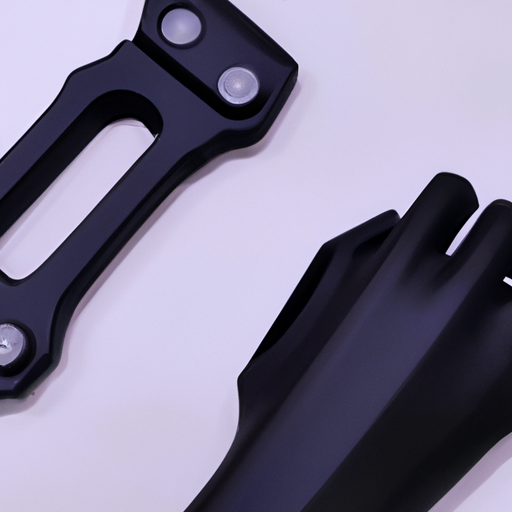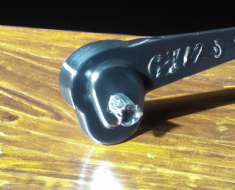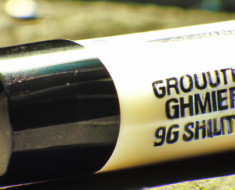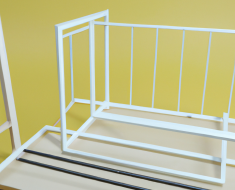“Enhance your grip, improve your aim.”
Pros and Cons of Hand Stop vs. Angled Foregrip
When it comes to optimizing your shooting experience, the choice between a hand stop and an angled foregrip can make a significant difference. Both accessories offer unique benefits and drawbacks that can affect your overall performance. In this article, we will explore the pros and cons of hand stops and angled foregrips to help you determine which option is better suited for your needs.
Let’s start by discussing hand stops. Hand stops are compact attachments that are designed to prevent your hand from sliding forward on the rail of your firearm. They provide a stable reference point for your support hand, allowing for consistent positioning and improved control. Hand stops are particularly popular among competitive shooters and tactical professionals who require precision and speed in their shooting.
One of the main advantages of hand stops is their versatility. They can be easily adjusted along the rail to accommodate different shooting styles and preferences. Additionally, hand stops are lightweight and do not add much bulk to your firearm, making them a convenient choice for those who prioritize mobility.
However, hand stops also have some limitations. Some shooters find that hand stops do not offer enough support for their grip, especially during rapid-fire sequences. Additionally, hand stops may not provide enough surface area for shooters with larger hands, leading to discomfort or instability.
On the other hand, angled foregrips offer a different approach to improving control and stability. Angled foregrips are designed to provide a forward grip angle that promotes a more natural shooting position. This can help reduce fatigue during extended shooting sessions and improve accuracy by minimizing muzzle rise.
One of the key advantages of angled foregrips is their ergonomic design. By allowing for a more comfortable grip angle, angled foregrips can help shooters maintain better control over their firearm. This can be particularly beneficial for shooters who prefer a more aggressive shooting stance or need to quickly transition between targets.
However, angled foregrips also have some drawbacks to consider. One common concern is that angled foregrips can add bulk to your firearm, which may affect its maneuverability in tight spaces or during rapid movements. Additionally, some shooters find that angled foregrips limit their ability to use certain shooting techniques or positions effectively.
In conclusion, both hand stops and angled foregrips offer unique advantages and drawbacks that can impact your shooting experience. When deciding between the two options, it is essential to consider your individual preferences, shooting style, and intended use for your firearm.
If you prioritize versatility and adjustability, a hand stop may be the better choice for you. On the other hand, if you value ergonomics and stability, an angled foregrip could be more suitable for your needs.
Ultimately, the best accessory for you will depend on your personal preferences and shooting goals. Experimenting with different options and seeking advice from experienced shooters can help you make an informed decision on whether a hand stop or an angled foregrip is better for you.
Performance Differences between Hand Stop and Angled Foregrip
When it comes to improving your shooting performance, choosing the right grip for your firearm is crucial. Two popular options are the hand stop and the angled foregrip. Both grips offer unique advantages, but which one is better for you? Let’s take a closer look at the performance differences between a hand stop and an angled foregrip to help you make an informed decision.
First, let’s discuss the hand stop. A hand stop is a small accessory that attaches to the bottom rail of your firearm. Its primary purpose is to prevent your hand from sliding forward on the rail during recoil. This can help you maintain a consistent grip and control over your weapon. Hand stops are particularly useful for precision shooting, as they allow you to place your hand in the same position every time, leading to more accurate shots.
On the other hand, an angled foregrip is designed to provide additional stability and control when handling your firearm. By gripping the foregrip at an angle, you can better manage recoil and reduce muzzle rise. This can be especially beneficial in rapid-fire situations or when shooting from unconventional positions. Angled foregrips are favored by many tactical shooters for their ability to enhance weapon handling and overall performance.
In terms of ergonomics, both grips have their strengths. A hand stop offers a minimalist design that won’t add bulk or weight to your firearm. This can be advantageous if you prefer a sleek and streamlined setup. On the other hand, an angled foregrip provides a larger surface area for your hand to grip, which can be more comfortable during extended shooting sessions.
When it comes to versatility, the angled foregrip may have a slight edge over the hand stop. The angled design allows for different gripping angles depending on your shooting style and preferences. Some shooters find that they can switch between a traditional grip and an angled grip with ease, giving them more flexibility in various shooting scenarios.
In terms of performance, both grips excel in different areas. A hand stop is ideal for precision shooting and maintaining a consistent grip position. If you prioritize accuracy and control over speed, a hand stop may be the better choice for you. On the other hand, an angled foregrip shines in fast-paced shooting situations where stability and recoil management are key factors. If you need to quickly engage multiple targets or shoot on the move, an angled foregrip may be more suitable for your needs.
Ultimately, the decision between a hand stop and an angled foregrip will depend on your shooting style, preferences, and intended use of your firearm. Consider factors such as ergonomics, versatility, and performance when choosing between these two popular grips. Whichever option you choose, remember that practice and training are essential for maximizing your shooting performance with any accessory. So take the time to familiarize yourself with your chosen grip and hone your skills on the range.
Ergonomics of Hand Stop and Angled Foregrip

When it comes to improving the ergonomics of your rifle, there are several accessories available on the market that can help enhance your shooting experience. Two popular options are the hand stop and angled foregrip, both of which serve different purposes but ultimately aim to provide better control and stability when handling your firearm.
The hand stop is a simple yet effective accessory that is designed to prevent your hand from sliding too far forward on the rifle’s handguard. This can help improve your grip and overall control of the weapon, especially during rapid fire or high-stress situations. Hand stops come in various shapes and sizes, but they all serve the same basic function of giving you a reference point for where to place your hand on the rifle.
On the other hand, angled foregrips are more versatile in their design and functionality. These grips typically have a slight angle that allows for a more natural wrist position when holding the rifle. This can help reduce fatigue and strain on your wrist during extended shooting sessions. Angled foregrips also provide a more secure grip on the rifle, which can be beneficial when shooting from unconventional positions or in close quarters.
One of the key differences between hand stops and angled foregrips is how they are used. Hand stops are typically placed near the front of the handguard, while angled foregrips are attached closer to the center of the rifle. This difference in placement can affect how you hold and manipulate the weapon, so it’s important to consider your shooting style and preferences when choosing between the two accessories.
In terms of comfort, both hand stops and angled foregrips offer benefits for shooters looking to improve their grip and control. Hand stops provide a solid reference point for your hand, which can help reduce fatigue and improve accuracy over time. Angled foregrips offer a more ergonomic design that can help alleviate wrist strain and discomfort during prolonged shooting sessions.
When it comes to versatility, angled foregrips have an edge over hand stops due to their ability to be used in a variety of shooting positions. Whether you’re standing, kneeling, or prone, an angled foregrip can provide added stability and control when handling your rifle. Hand stops, while effective for improving grip and control, may not offer as much versatility in terms of shooting positions.
Ultimately, the decision between a hand stop and an angled foregrip comes down to personal preference and shooting style. If you prioritize a solid reference point for your hand placement, a hand stop may be the better option for you. If you’re looking for a more ergonomic grip that can provide added stability in various shooting positions, an angled foregrip may be more suitable.
Regardless of which accessory you choose, both hand stops and angled foregrips can help improve the ergonomics of your rifle and enhance your overall shooting experience. Experiment with different options to find what works best for you and remember that comfort and control are key factors in maximizing your performance on the range or in the field.
Tactical Considerations for Choosing Hand Stop or Angled Foregrip
When it comes to optimizing your firearm for tactical use, every accessory and attachment plays a crucial role in enhancing your shooting performance. Two popular options for improving your grip and control on a rifle are hand stops and angled foregrips. Both have their own unique benefits and considerations, so it’s important to understand the differences between the two before making a decision on which one is better suited for your needs.
Hand stops are designed to provide a reference point for your support hand, allowing for consistent placement and improved stability when shooting. They are typically mounted at the front of the handguard and are used to prevent your hand from sliding forward during rapid fire or recoil. Hand stops come in various shapes and sizes, but they all serve the same basic purpose of helping you maintain a secure grip on your rifle.
On the other hand, angled foregrips are designed to provide a more ergonomic grip angle for your support hand. By angling the grip forward, angled foregrips help reduce wrist strain and fatigue during extended shooting sessions. They also provide a more natural point of contact for your hand, allowing for better control and accuracy when aiming downrange.
One key consideration when choosing between a hand stop and an angled foregrip is how you plan to use your rifle. If you primarily engage targets at close range or in confined spaces, a hand stop may be more beneficial as it allows for quick transitions between targets and provides added stability during rapid fire. However, if you frequently engage targets at longer distances or need to maintain precision accuracy, an angled foregrip may be the better option as it helps improve your shooting stance and control.
Another factor to consider is personal preference and comfort. Some shooters may find that a hand stop offers a more secure grip and better control over their rifle, while others may prefer the ergonomic design of an angled foregrip. It’s important to test out both options before making a decision to see which one feels more natural and comfortable for you.
In terms of installation and compatibility, both hand stops and angled foregrips can be easily mounted on most modern rifles with picatinny rails or M-LOK attachment points. It’s important to ensure that the attachment method matches your rifle’s rail system to prevent any issues with stability or fitment.
Ultimately, the decision between a hand stop and an angled foregrip comes down to personal preference, shooting style, and intended use. Both options offer unique benefits and considerations that can help enhance your shooting performance and overall experience with your rifle. Whether you choose a hand stop or an angled foregrip, make sure to practice with your new accessory to familiarize yourself with its feel and performance before heading out to the range or field.
User Preferences and Recommendations for Hand Stop vs. Angled Foregrip
When it comes to enhancing your shooting experience, having the right accessories can make all the difference. Two popular options for improving grip and stability on your firearm are hand stops and angled foregrips. Both serve similar purposes, but there are distinct differences between the two that may influence your decision on which to choose.
Hand stops are designed to provide a reference point for your support hand, allowing for a consistent grip and improved control over your weapon. They are typically small, lightweight, and attach directly to the rail system of your firearm. Hand stops come in a variety of shapes and sizes, allowing you to customize the fit to your preference.
On the other hand, angled foregrips are more substantial in size and provide a larger surface area for gripping your firearm. Angled foregrips are designed to be held at an angle, allowing for a more ergonomic grip that can help reduce fatigue during extended shooting sessions. They also provide additional support when shooting from unconventional positions.
One of the key factors to consider when choosing between a hand stop and an angled foregrip is how you plan to use your firearm. If you primarily shoot in a stationary position, such as from a bench or prone position, a hand stop may be more suitable for your needs. The compact size of a hand stop allows for easy maneuverability and can help prevent snagging on gear or clothing.
On the other hand, if you frequently find yourself shooting on the move or in dynamic situations where quick target transitions are necessary, an angled foregrip may be the better option. The larger surface area of an angled foregrip provides more stability and control over your firearm, making it easier to maintain accuracy while on the move.
Ultimately, the decision between a hand stop and an angled foregrip comes down to personal preference and how you intend to use your firearm. Some shooters may prefer the minimalist design of a hand stop, while others may appreciate the added support and ergonomics of an angled foregrip.
If you’re still unsure which option is best for you, it may be helpful to try out both accessories before making a decision. Many shooting ranges and gun stores offer rental options for accessories like hand stops and angled foregrips, allowing you to test them out before committing to a purchase.
In conclusion, both hand stops and angled foregrips have their own unique benefits and drawbacks. The best option for you will depend on your individual shooting style and preferences. Whichever accessory you choose, make sure to practice with it regularly to ensure you are comfortable and proficient with its use. Ultimately, the goal is to enhance your shooting experience and improve your accuracy on the range or in the field.






